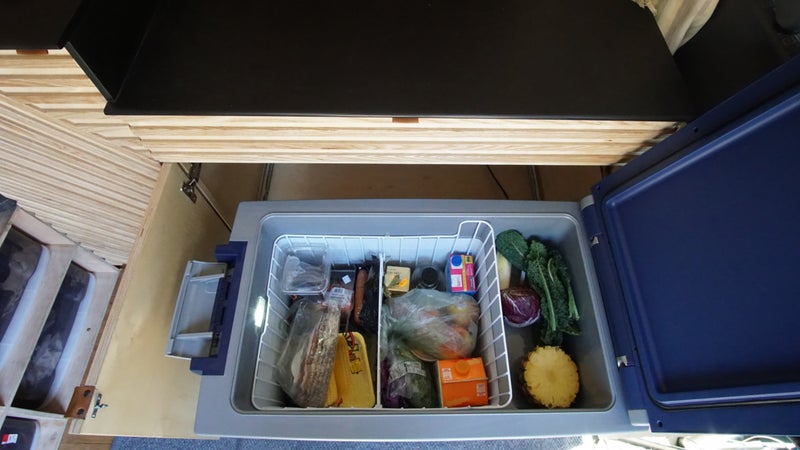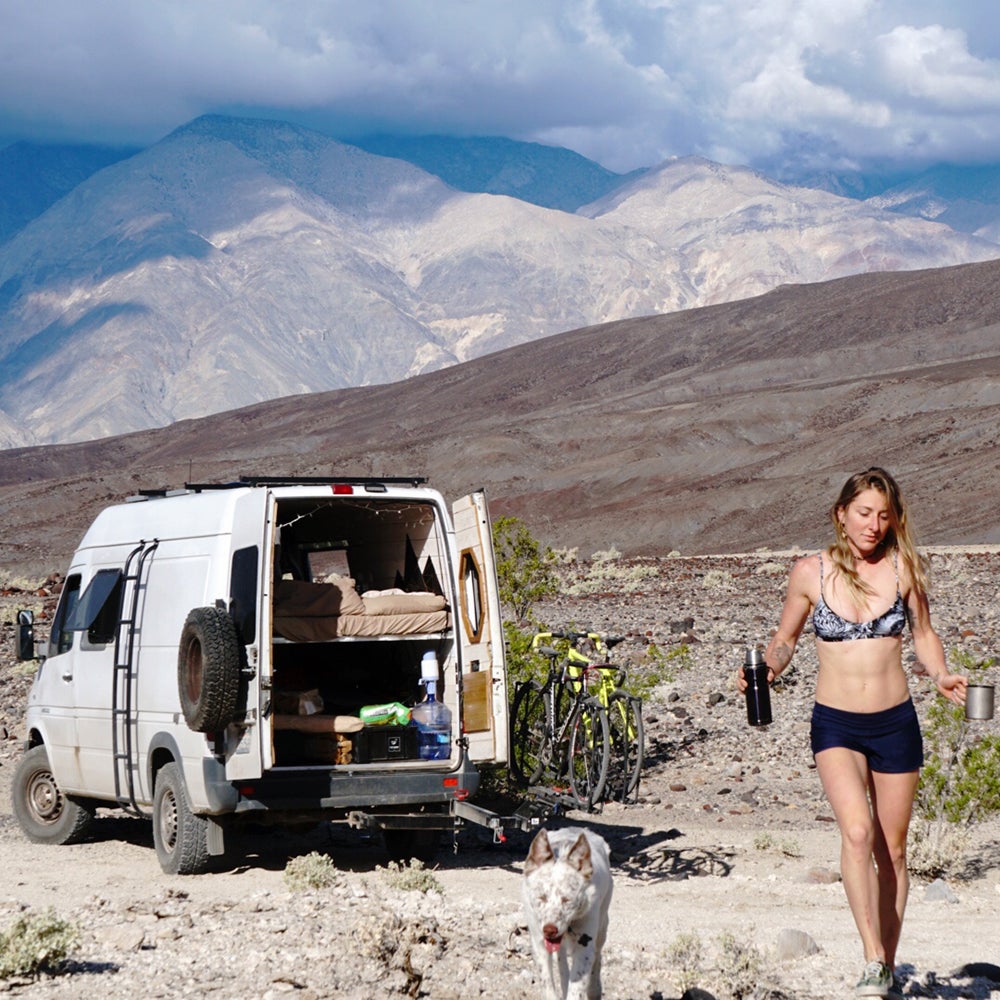MacKenzie and Tommy are living the dream. They’re traveling the world rent-free, accompanied by an awesome dog, doing all the climbing, mountain biking, and dirt biking they feel like. They pay for it all by making art on the side and keeping expenses to a minimum. Moving into a van was the key.
Here’s how it’s working out, eight months in.
How Do They Earn Money?
The formerly Los Angeles–based couple make stuff out of wood. That might be a window display for a big clothing chain, a pop-up installation at Austin’s SXSW for the biggest company on earth, or some inlaid art pieces for a gallery in Venice. MacKenzie and Tommy are good at all of that—good enough that their incomes allowed them each to have their own apartments in nice neighborhoods, plus a two-car garage that served as a shared workshop. They had motorcycles. They had trucks. They had nice mountain bikes.
They still make art, just a little less of it. By downsizing—cutting out two rents, two trucks, and one motorcycle—they have a lot more money to put toward travel even though overall they’re earning less. “We’ve missed out on a couple cool business opportunities,” says Tommy. “Chalk it up to the game. We’re able to take off for long periods of traveling.”
Right now, MacKenzie says they’re spending more than half their time in Los Angeles while living out of the van. That’s not ideal, and they’re working on ways to make their work travel better. The workshop keeps them tethered to the city for half the year.
Why Van Life?
“We couldn’t have a dog at either of our old apartments,” explains Tommy. Right now, the L.A. real estate market has too much demand and not enough supply. Rents are expensive, cool spots are hard to find, and all the power lies with the landlords.
The pair wanted to establish control over their lives. The van enabled that and freed up enough money that they could rent space in a larger workshop, allowing them to work more efficiently and make more in less time.
“We wanted to live somewhere with open land, in a living space that we both envisioned taking from start to finish,” says MacKenzie. Buying that land and building a house on it isn’t a current reality. But with the van, they’re free to wake up where they choose most mornings. And that’s usually somewhere away from people and with the beautiful views you see in these photos.
The rest of the time? Well, that’s not so ideal. “Everyday van life isn’t as glamorous as it might look,” says MacKenzie. When they’re in town working, they wake up looking at a city street, not an empty desert, and cook dinner in a city park. “It takes a lot of humility to make this work, but we both see a lot of value in doing it this way,” she says. The sacrifice pays off. Already this year, the couple spent two weeks driving the van through Baja, Mexico, and were able to fly to New Zealand and rent another van for a solid month.
“If we make some sacrifices, we get to do really cool and fun stuff,” says Tommy.
The Van
It’s a 2005 Mercedes Sprinter. Over their truck-based American counterparts, European vans like these are built like cars, maximizing interior space and lowering the floor as much as possible. Those factors maximize versatility and make it easy to load big gear. Tommy and MacKenzie can stand up inside, no pop-top necessary.
The budget didn’t stretch to a 4×4, and the couple thought the larger, long-wheelbase model would be hard to park, so this is the smaller, two-wheel drive version. Nothing fancy, but over the past nine months, this humble van has become a blank canvas for their creativity.
The first step in any build is stripping the van to its bare shell and addressing any corrosion concerns. You’ll lose access to the much of the van’s interior skin once you add the insulation.
Insulation is the next step. With only a thin metal layer between you and the outside world, vans can be noisy and subject to the outside temperature. Tommy started by applying RoadKill aluminized rubber sound-deadening material throughout the van’s interior. For the floor, he applied closed-cell foam, sound board, felt underlayment, and handmade bamboo flooring. The result looks nice and keeps the interior quiet and comfortable at camp and on the freeway.
On the walls, they used shredded-denim insulation, then Reflectix, and plastic sheeting to serve as a moisture barrier. Their van is intended to be a home, so they built it like one. On top of the functional stuff, Tommy applied a custom skin of whitewashed cedar. The van originally had no windows, so they shopped for generic RV items on eBay and cut holes in the exterior. Tommy cut hexagonal holes in the wood over the rear windows to make them feel more like a cabin. Pockets hide the blackout curtains when they’re rolled up and hold the material flush to the window when unrolled.
Electronics in the passenger compartment run off a separate electrical system from the van’s powertrain. Keeping the stock driving components maximizes reliability and serviceability while cutting costs and complications. Two roof-mounted solar panels feed a battery and inverter that power the fridge, interior lights, exterior flood lamp, roof-mounted ventilation fan, and the water pump for their sink.
One of the biggest challenges was figuring out the bed. The couple wanted room to stow their mountain bikes underneath without taking the wheels off. The Mercedes’ low floor and tall roof made that possible as long as they went with a slim frame and thin mattress.
MacKenzie and Tommy wanted to be able to stretch out in the bed, so they oriented it lengthwise and installed a kitchen counter to the exact dimensions between the front seat and the bed frame. The kitchen includes a sink that draws from an under-bed drinking-water tank and drains into a gray-water container underneath. They also built a custom slide for an ARB fridge/freezer—an invaluable addition that allows them to keep food fresh on extended trips.
There’s just enough room in front of the bed for one person to cook, clean, or make coffee while standing up. That makes street parking possible, but things get much easier when they’re camping. A large ARB awning with walls and bug net essentially quadruples their interior living space. The van opens up into the awning room, allowing the couple to keep the entire living area dry and free of bugs.
Simplicity is flexibility. By using a standard portable propane stove, they’re able to cook inside or out, depending on where the van is parked. There’s plenty of room under the bed for gear storage, depending on what they have with them. Inside, the van is spacious, bright, and sleek.
The main structures are bolted to the van’s metal frame for strength and safety, but all the little pieces remain a work in progress. Tracking down squeaks and rattles, Tommy and MacKenzie are slowly ironing out the kinks and making the van uniquely quiet and comfortable on the move.

On an early trip to one of the hot springs outside Mammoth, California, MacKenzie and Tommy were waylaid by a flat tire on a dirt road. On went a set of tougher all-terrain tires. As a bonus, the tires’ added traction makes up for the van’s lack of four-wheel drive. In Baja, the van’s added weight caused it to bottom out on dirt roads, so they added a set of Fox Racing shocks and upgraded the springs, along with a two-inch Van Compass lift. Now their van is able to go pretty much anywhere.
As a final touch, Tommy installed one of his art pieces. “MacKenzie always wanted one of my pieces, so I made that for her, and now it gets to go everywhere with us,” he tells me.
All told, they spent just shy of $20,000, including the van itself. In other words: about six months of rent in Los Angeles.
What’s Next?
“It never really feels great sitting in L.A. traffic after being without cell signal for days at a time,” says Tommy. He and MacKenzie are looking for ways to maximize their time on the road. “We want to live van life—real van life, not weekend van life,” says MacKenzie.
Tommy plans to apply more decorative work to the cabinets before the couple takes off for a month in Canada this summer.
Until then, they’re focusing on the goal: working hard enough to put enough money into the bank to fund their travels without having to turn their whole life over to something other than their passion. “We have to remember to make space for all the things that motivated us to make this decision,” says MacKenzie. “We have to focus on exercising the the good parts of van life.”

